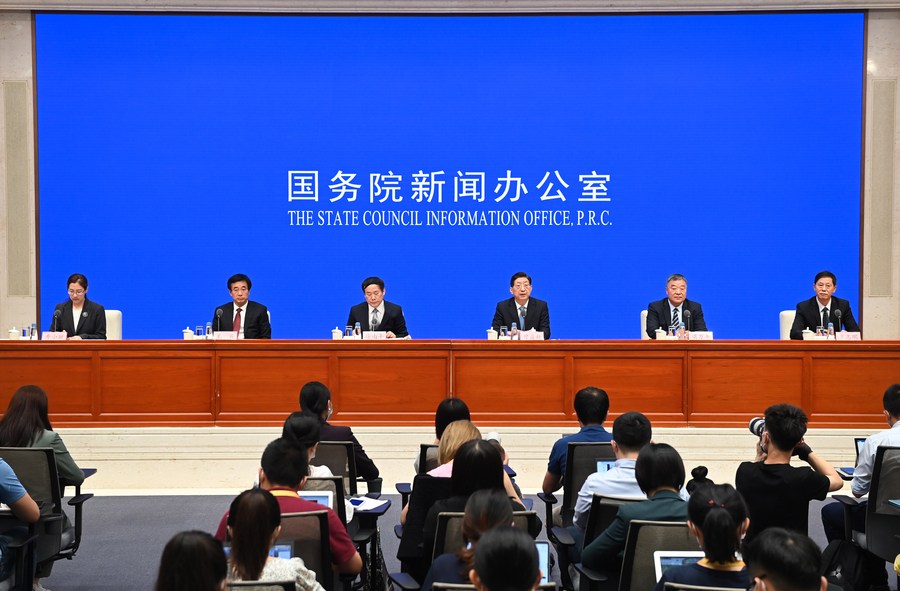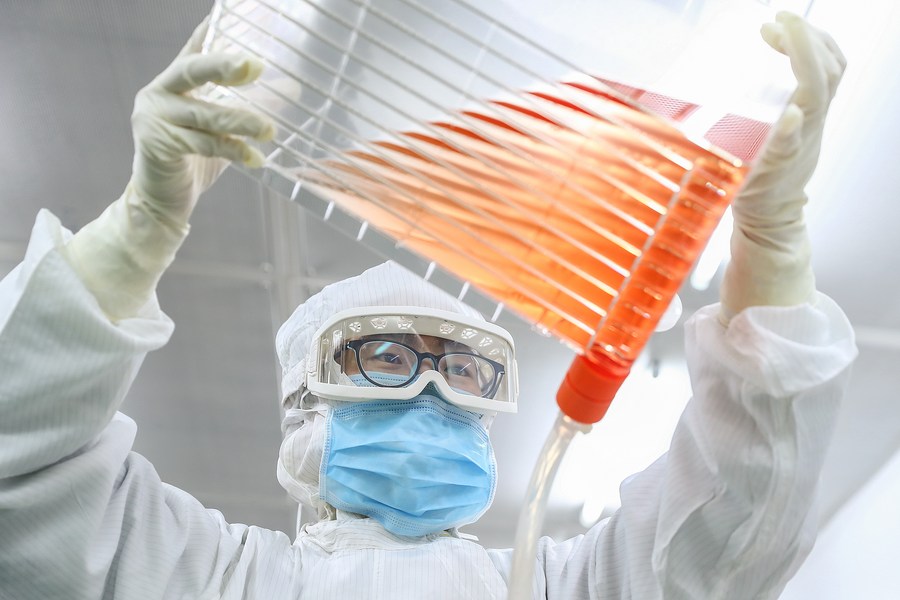Lesson behind hyperbole of Chinese researchers withdrawing COVID data
-- A Western media firestorm suspecting China hid early COVID-19 data in Wuhan turned out to be much ado about nothing, as the Chinese clarification that Wuhan researchers' withdrawal of data originated in an editorial mistake by an international academic journal now backed by the journal.
-- The Chinese researchers at the center of the controversy have been waiting for an official correction from the journal and kept the distance from the politicized debate in public. A U.S. researcher, who initiated the drama with a highly speculative theory, didn't respond to a Xinhua request for comment.
-- The withdrawn data has little value to COVID-19 origin tracing, as it was based on samples collected on the day when China reported almost 10,000 confirmed cases in total; also, the data was meant for a new testing method and didn't reach the level of accuracy meaningful for origin tracing.
BEIJING, Aug. 7 (Xinhua) -- A Western media firestorm suspecting China hid early COVID-19 data in Wuhan turned out to be much ado about nothing, with a boring answer and alarming lesson for everyone who -- inadvertently or not -- played a part.
In late June, Dr. Jesse Bloom, a virologist at the Fred Hutchinson Cancer Research Center in the United States, said on Twitter that a set of SARS-CoV-2 sequences based on samples collected in Wuhan was withdrawn by local researchers from a database in the U.S.
Bloom also alleged that the fact the data "was deleted should make us skeptical that all other relevant early Wuhan sequences have been shared."
Within a day or two, multiple Western media outlets reported Bloom's finding when the Wuhan researchers didn't immediately comment, fueling widespread suspicion such as "deliberate obfuscation" in the words of a U.S. professor in the Financial Times.
On July 22, Dr. Zeng Yixin, vice-minister of the National Health Commission, refuted Bloom's allegations of a cover-up at a press conference in Beijing.
A day later, two Xinhua journalists independently reached a Wuhan researcher at the center of the controversy by phone, who confirmed the Chinese official's account with more details -- and a self-reflection.
Still spooked by the international hyperbole, the researcher insisted on anonymity.
On July 29, SMALL, an international academic journal, published a correction with an apology, confirming the aligning accounts of the Chinese official and the researcher.
EDITORIAL ERROR
SMALL published a paper called "Nanopore Targeted Sequencing for the Accurate and Comprehensive Detection of SARS-CoV-2 and Other Respiratory Viruses" on June 24, 2020. The authors were led by a team of Chinese researchers.
The researchers collected throat swab clinical samples from Wuhan residents and then performed their nanopore targeted sequencing (NTS) on the samples, producing COVID-19 data, according to the paper.
The researchers uploaded their data on the U.S. database, and included a paragraph describing how to access the data, said Zeng on July 22.

The State Council Information Office holds a press conference on the novel coronavirus origin-tracing work in Beijing, capital of China, July 22, 2021. (Xinhua/Chen Yehua)
The Wuhan researcher said the same thing. As proof, the researcher shared, with the two Xinhua journalists, a snapshot of the Data Accessibility paragraph in their submitted paper to SMALL.
But when SMALL sent a draft for publication back to them, the paragraph was gone, according to another snapshot shared by the researcher.
"When we saw that the journal had deleted the paragraph, we believed that then the paragraph was unnecessary," the researcher said.
The published paper did not include the paragraph. Following that, the researchers withdrew their data from the U.S. database, thinking its storage was no longer necessary. Furthermore, the information could have been deduced from the tables and graphs in the published paper, the researcher added.
The Wuhan researcher's account of the events was first reported by the two Xinhua journalists in newsletters in their personal capacity.
On July 29, what SMALL said in a correction on its website confirmed the Chinese account, "In the originally published article, the Data Availability paragraph of the experimental section was mistakenly deleted during the copyediting process. The original sequencing data has been submitted to China National Center for Bioinformation GSA database."
"The editorial office apologizes for any inconvenience caused," the correction said.
The Chinese database mentioned in the correction is open to international researchers.
WILD SUSPICION
But before the correction emerged, Bloom, the virologist in the United States, had already developed and published his suspicion.
According to a snapshot shared by Wuhan researcher, Bloom wrote in a June 7 email asking, "why the raw sequencing data for the study are no longer available?"
The Chinese researchers didn't reply, as the researcher said they didn't know Bloom, and that they thought -- they still think -- if they were to share the raw sequencing data, the best way was to upload them to a database and make it public, not exclusively with one person.
Bloom is the lead signatory to a May 14 letter saying, on the origin of SARS-CoV-2, "theories of accidental release from a lab and zoonotic spillover both remain viable," the Wuhan researcher also noted in the phone interview.
The lab leak theory was described as "extremely unlikely" in the joint World Health Organisation-China study on the origins of SARS-CoV-2.
On June 23 Beijing time, Bloom published a preprint -- a paper not yet peer-reviewed -- and a lengthy Twitter thread, describing how he discovered and recovered the withdrawn data, adding that "there are also broader implications" such as "this data was deleted should make us skeptical that all other relevant early Wuhan sequences have been shared."
The thread set off a wave of reports in major Western media outlets on the same day of its publication or the next, when the Chinese researchers "did not immediately respond to emails inquiring about Dr. Bloom's finding," as reported by The New York Times.
The Wuhan researcher said the authors, who have little experience of talking to the media -- especially those in the West, found the accusation unacceptable and offensive, and they were overwhelmed by the sudden, simultaneous Western media focus.
LITTLE VALUE
Another key argument put forward by Zeng, the Chinese vice-minister, and the Wuhan researcher was that the withdrawn data was of little value to COVID-19 origin tracing.
The paper said the data was based on samples from people in Wuhan of "suspected COVID-19 early in the epidemic (January 2020)," which was seized by Bloom and others to speculate that the withdrawal was to conceal valuable data.
However, Zeng and the Wuhan researcher clarified that the earliest sample was collected on January 30, 2020, and thus was not valuable for COVID-19 origin tracing.
According to the China Part of the joint WHO-China study, the earliest onset date in China's COVID-19 reporting system was December 8, 2019.
By January 30, 2020, which is almost two months later, China reported 9,692 confirmed cases and 15,238 suspected cases.

People have their information registered before taking COVID-19 nucleic acid tests in Wuhan, central China's Hubei Province, Aug. 3, 2021. (Xinhua/Wu Zhizun)
The Chinese researcher also said that since the Wuhan researchers' intention was only to test a new sequencing method, the quality of their sequence and data didn't have to -- and therefore didn't -- reach the level of accuracy meaningful for COVID-19 origin tracing.
The Chinese researcher said that their raw sequencing data was like covering only a few digits of a dozen-digit-long ID number; to use their raw sequencing data to identify the person behind the ID number would be impossible -- they don't even have the whole ID number; and that scientists in the same field worth their salt should have known this.
A REFLECTION
It was not until almost a month later when Zeng, the Chinese vice-minister, publicly addressed the controversy in Beijing on July 22.
"After this incident was reported, we immediately conducted an investigation and gained an understanding of it," Zeng told the press conference.
Zeng also blasted Bloom, saying the U.S. researcher "without confirmation from the Chinese researchers and having no knowledge of the ins and outs of the matter, made up a conspiracy theory saying it was a cover-up."
In the meantime, Bloom's suspicion and sympathetic Western press coverage -- without Chinese accounts -- dominated the public discourse in English.
After Zeng spoke and the two Xinhua journalists interviewed the Wuhan researcher, the Chinese side of the story surfaced.
A New York Times column, on July 30, included the Chinese account by citing and corroborating the Xinhua journalists' personal newsletter.
"While the disappearance of the sequences appears to be the result of an editorial error, Dr. Bloom felt that it was still worthwhile looking for other sequences of coronaviruses that might be lurking online," the column added.
Compared with the media-savvy Bloom, who was widely quoted in the press coverage and whose lab counts over 20,000 followers on Twitter, the Wuhan researcher doesn't have identifiable social media accounts and approaches the controversy in a strictly academic fashion, patiently waiting for a correction from the journal.
Throughout the interview and subsequent communication, the Wuhan researcher, apparently uninterested in politics or conspiracy theories, insisted that the only thing that could completely exonerate the authors was for SMALL to issue a correction confirming the Data Availability paragraph was indeed mistakenly deleted by the journal.
That was one key reason the authors have remained silent, so as not to embarrass SMALL publicly, said the Wuhan researcher, adding that their concern had been if they highlighted the editorial error before SMALL did, that could complicate a correction from the journal.

A staff member cultivates Vero cells at Sinovac Life Sciences Co., Ltd. in Beijing, capital of China, March 23, 2020. (Xinhua/Zhang Yuwei)
When pressed by two Xinhua journalists on why not respond publicly earlier, the Wuhan researcher said "I ask for your understanding -- at the time, I didn't know what to do. There was nobody telling me what to do."
That admission, coupled with Zeng's statement that the Chinese government only began to investigate the matter after media reports, stood in stark contrast with the wide speculation in the West that the withdrawal was a "deliberate obfuscation" and "deliberate obstruction."
It's unknown if Bloom has any reflection from the drama that he started. He didn't respond to an emailed request for comments.
Photos
Related Stories
- Science-based origin tracing of COVID-19 allows no vicious political manipulation
- Sunshine of cooperation will finally dispel dark cloud of COVID-19
- Overseas experts appreciate China's commitment to global anti-COVID-19 fight
- Scientists from 4 BRICS countries to carry out genomic sequencing, mathematical modelling of COVID-19 pandemic
- Hey America! Now it is your turn
Copyright © 2021 People's Daily Online. All Rights Reserved.










